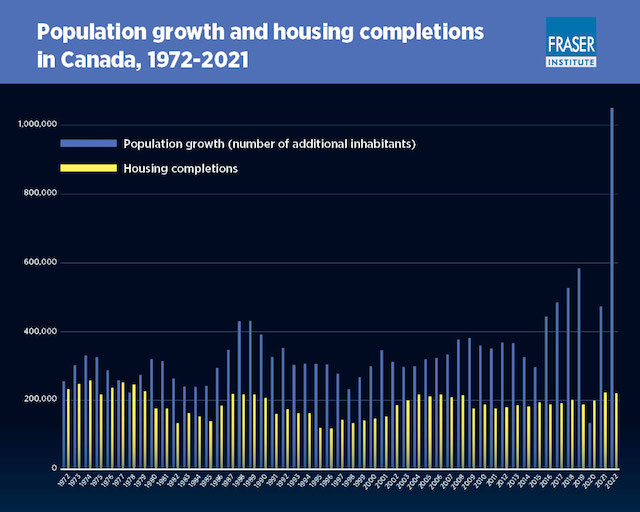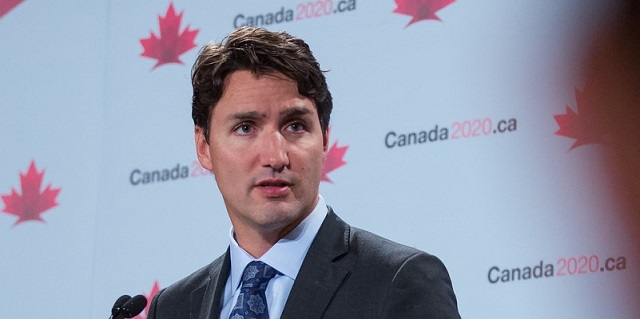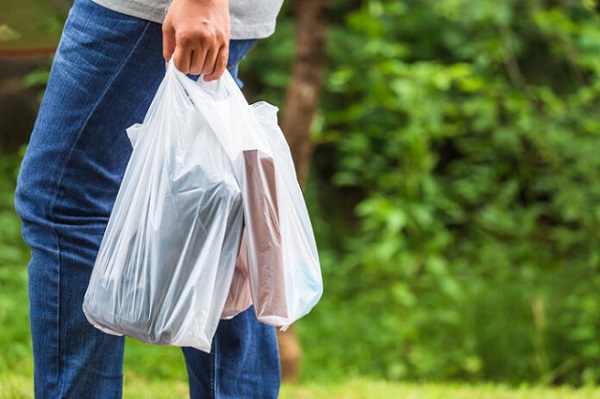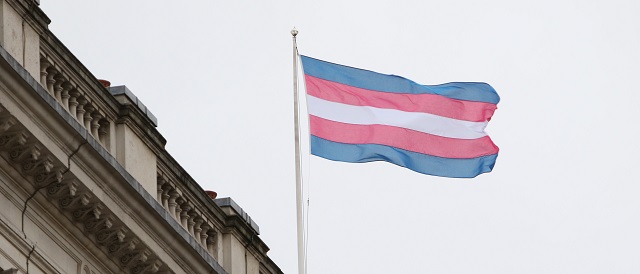Business
Housing completions not keeping pace with population

From the Fraser Institute
2018 to 2022, population growth averaged more than 550,000 per year compared to only 200,000 new homes
In Canada, the gap between the number of homes built and the number of additional people is the widest it’s been in 50 years, finds a new study released today by the Fraser Institute, an independent, non-partisan, Canadian public policy think-tank.
“Canada faces an historic gap between population growth and the number of homes built—and Canadians are paying the price,” said Josef Filipowicz, senior fellow at the Fraser Institute and author of Canada’s Growing Housing Gap: Comparing Population Growth and Housing Completions in Canada, 1972-2022.
From 2018 to 2022 (the latest year of available data), Canada’s population grew by 553,568 people (each year, on average) compared to an annual average of only 205,762 new homes built.
In other words, over the last five years housing completions equalled less than 40 per cent of population growth—a stark difference from the early 1970s when population growth almost equalled housing completions. Specifically, from 1972 to 1976, the population grew (on average) by 299,843 people per year compared to an average of 237,853 new homes built.
In the most populous province, we see similar trends. During the same five-year period (2018 to 2022), Ontario’s population grew by 239,915 people (each year, on average) compared to an annual average of only 70,828 new homes built.
“Until policymakers help close the gap between supply and demand, affordable housing will remain out of reach to an ever-greater share of Canada’s population,” Filipowicz said
Main Conclusions
- This research bulletin compares annual population growth in Canada with housing completions between 1972 and 2022.
- The growth of the population reached its highest point, nationally and in every province, in 2022.
- Meanwhile, housing completions have stabilized or declined. Nationally, Canada has yet to build more homes annually than it did during the 1970s. This is also the case in 9 out of 10 provinces.
- Throughout most of this period, Canada’s population grew by one to three people for every housing unit completed the previous year.
- In 2022, population grew by 4.7 people for every unit completed the previous year—higher than at any other time.
- Among the provinces, this ratio ranges from 2.8 people per home completed in Quebec to 11.3 people per completion in New Brunswick in 2022.
- Without closing the wide, growing gap between housing demand (population growth) and housing supply (housing completions), Canadians’ current struggles with high housing costs are likely to persist, if not worsen.
Economy
Prime minister’s misleading capital gains video misses the point

From the Fraser Institute
By Jake Fuss and Alex Whalen
According to a 2021 study published by the Fraser Institute, 38.4 per cent of those who paid capital gains taxes in Canada earned less than $100,000 per year, and 18.3 per cent earned less than $50,000. Yet in his video, Prime Minister Trudeau claims that his capital gains tax hike will affect only the richest “0.13 per cent of Canadians”
This week, Prime Minister Trudeau released a video about his government’s decision to increase capital gains taxes. Unfortunately, he made several misleading claims while failing to acknowledge the harmful effects this tax increase will have on a broad swath of Canadians.
Right now, individuals and businesses who sell capital assets pay taxes on 50 per cent of the gain (based on their full marginal rate). Beginning on June 25, however, the Trudeau government will increase that share to 66.7 per cent for capital gains above $250,000. People with gains above that amount will again pay their full marginal rate, but now on two-thirds of the gain.
In the video, which you can view online, the prime minister claims that this tax increase will affect only the “very richest” people in Canada and will generate significant new revenue—$20 billion, according to him—to pay for social programs. But economic research and data on capital gains taxes reveal a different picture.
For starters, it simply isn’t true that capital gains taxes only affect the wealthy. Many Canadians who incur capital gains taxes, such as small business owners, may only do so once in their lifetimes.
For example, a plumber who makes $90,000 annually may choose to sell his business for $500,000 at retirement. In that year, the plumber’s income is exaggerated because it includes the capital gain rather than only his normal income. In fact, according to a 2021 study published by the Fraser Institute, 38.4 per cent of those who paid capital gains taxes in Canada earned less than $100,000 per year, and 18.3 per cent earned less than $50,000. Yet in his video, Prime Minister Trudeau claims that his capital gains tax hike will affect only the richest “0.13 per cent of Canadians” with an “average income of $1.4 million a year.”
But this is a misleading statement. Why? Because it creates a distorted view of who will pay these capital gains taxes. Many Canadians with modest annual incomes own businesses, second homes or stocks and could end up paying these higher taxes following a onetime sale where the appreciation of their asset equals at least $250,000.
Moreover, economic research finds that capital taxes remain among the most economically damaging forms of taxation precisely because they reduce the incentive to innovate and invest. By increasing them the government will deter investment in Canada and chase away capital at a time when we badly need it. Business investment, which is crucial to boost living standards and incomes for Canadians, is collapsing in Canada. This tax hike will make a bad economic situation worse.
Finally, as noted, in the video the prime minister claims that this tax increase will generate “almost $20 billion in new revenue.” But investors do not incur capital gains taxes until they sell an asset and realize a gain. A higher capital gains tax rate gives them an incentive to hold onto their investments, perhaps until the rate is reduced after a change in government. According to economists, this “lock-in” effect can stifle economic activity. The Trudeau government likely bases its “$20 billion” number on an assumption that investors will sell their assets sooner rather than later—perhaps before June 25, to take advantage of the old inclusion rate before it disappears (although because the government has not revealed exactly how the new rate will apply that seems less likely). Of course, if revenue from the tax hike does turn out to be less than anticipated, the government will incur larger budget deficits than planned and plunge us further into debt.
Contrary to Prime Minister Trudeau’s claims, raising capital gains taxes will not improve fairness. It’s bad for investment, the economy and the living standards of Canadians.
Authors:
Business
Ottawa should end war on plastics for sake of the environment

From the Fraser Institute
Here’s the shocker: Meng shows that for 15 out of the 16 uses, plastic products incur fewer GHG emissions than their alternatives…
For example, when you swap plastic grocery bags for paper, you get 80 per cent higher GHG emissions. Substituting plastic furniture for wood—50 per cent higher GHG emissions. Substitute plastic-based carpeting with wool—80 per cent higher GHG emissions.
It’s been known for years that efforts to ban plastic products—and encourage people to use alternatives such as paper, metal or glass—can backfire. By banning plastic waste and plastic products, governments lead consumers to switch to substitutes, but those substitutes, mainly bulkier and heavier paper-based products, mean more waste to manage.
Now a new study by Fanran Meng of the University of Sheffield drives the point home—plastic substitutes are not inherently better for the environment. Meng uses comprehensive life-cycle analysis to understand how plastic substitutes increase or decrease greenhouse gas (GHG) emissions by assessing the GHG emissions of 16 uses of plastics in five major plastic-using sectors: packaging, building and construction, automotive, textiles and consumer durables. These plastics, according to Meng, account for about 90 per cent of global plastic volume.
Here’s the shocker: Meng shows that for 15 out of the 16 uses, plastic products incur fewer GHG emissions than their alternatives. Read that again. When considering 90 per cent of global plastic use, alternatives to plastic lead to greater GHG emissions than the plastic products they displace. For example, when you swap plastic grocery bags for paper, you get 80 per cent higher GHG emissions. Substituting plastic furniture for wood—50 per cent higher GHG emissions. Substitute plastic-based carpeting with wool—80 per cent higher GHG emissions.
A few substitutions were GHG neutral, such as swapping plastic drinking cups and milk containers with paper alternatives. But overall, in the 13 uses where a plastic product has lower emissions than its non-plastic alternatives, the GHG emission impact is between 10 per cent and 90 per cent lower than the next-best alternatives.
Meng concludes that “Across most applications, simply switching from plastics to currently available non-plastic alternatives is not a viable solution for reducing GHG emissions. Therefore, care should be taken when formulating policies or interventions to reduce plastic demand that they result in the removal of the plastics from use rather than a switch to an alternative material” adding that “applying material substitution strategies to plastics never really makes sense.” Instead, Meng suggests that policies encouraging re-use of plastic products would more effectively reduce GHG emissions associated with plastics, which, globally, are responsible for 4.5 per cent of global emissions.
The Meng study should drive the last nail into the coffin of the war on plastics. This study shows that encouraging substitutes for plastic—a key element of the Trudeau government’s climate plan—will lead to higher GHG emissions than sticking with plastics, making it more difficult to achieve the government’s goal of making Canada a “net-zero” emitter of GHG by 2050.
Clearly, the Trudeau government should end its misguided campaign against plastic products, “single use” or otherwise. According to the evidence, plastic bans and substitution policies not only deprive Canadians of products they value (and in many cases, products that protect human health), they are bad for the environment and bad for the climate. The government should encourage Canadians to reuse their plastic products rather than replace them.
Author:
-

 Brownstone Institute22 hours ago
Brownstone Institute22 hours agoMedical Elites’ Disgrace Over Ivermectin
-

 National20 hours ago
National20 hours agoDespite claims of 215 ‘unmarked graves,’ no bodies have been found at Canadian residential school
-

 Brownstone Institute15 hours ago
Brownstone Institute15 hours agoThe WHO’s Proposed Pandemic Agreements Worsen Public Health
-

 COVID-193 hours ago
COVID-193 hours agoJapan’s most senior cancer doctor: COVID shots are ‘essentially murder’
-

 John Stossel9 hours ago
John Stossel9 hours agoProtecting Free Speech: The Early Warning Signs From Around The World
-

 COVID-1912 hours ago
COVID-1912 hours agoTrudeau’s public health agency recommends another experimental COVID booster
-

 Health13 hours ago
Health13 hours agoTHE WPATH TAPES: Behind-The-Scenes Recordings Reveal What Top Gender Doctors Really Think About Sex Change Procedures
-

 COVID-1916 hours ago
COVID-1916 hours agoThe New York Times Admits Injuries from COVID-19 Shots







